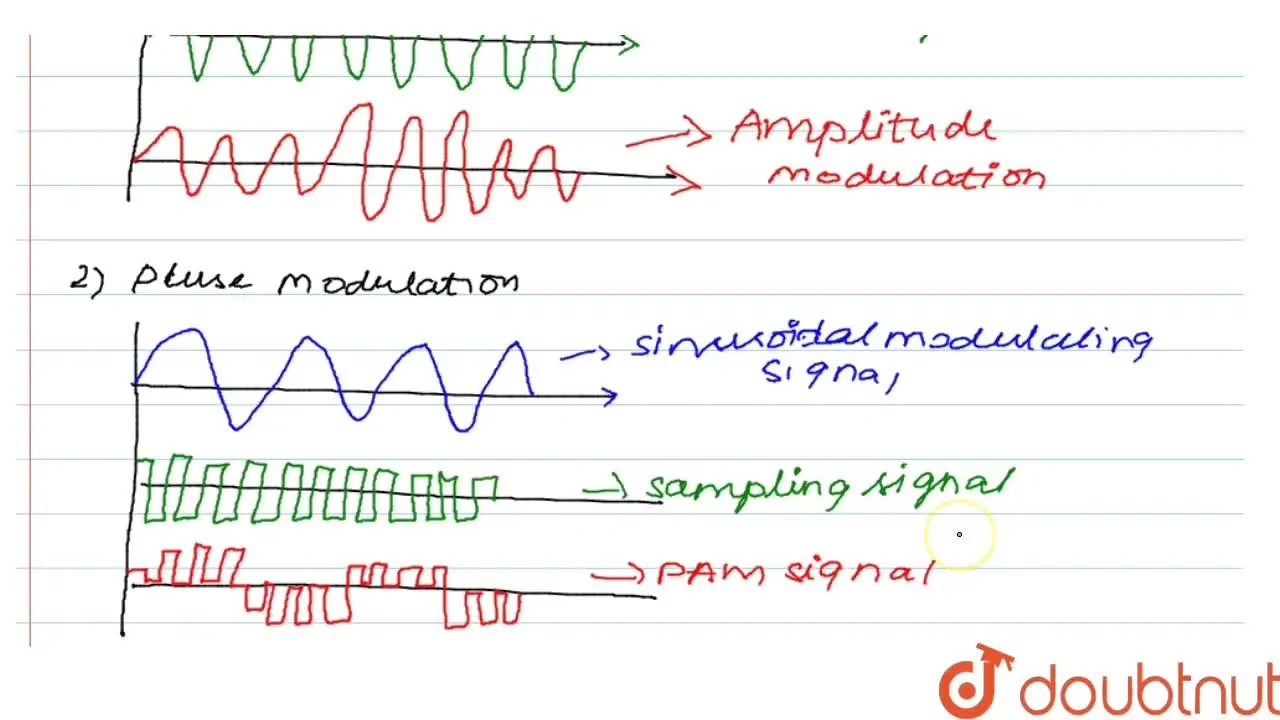What is modulation? Explain the types of modulation with necessary diagrams.Solution in Tamil
Modulation: For long distance transmission, the low frequency baseband signal input signal) is superimposed onto a high frequency radio signal by a process called modulation There are 3 types of modulation based on which parameter is modified. They are (1) Amplitude modulation, (ii) Frequency modulation, and (iii) Phase modulation.
(i) Amplitude Modulation (AM): If the amplitude of the carrier signal is modified according to the instantaneous amplitude of the baseband signal, then it is called amplitude modulation. Here the frequency and the phase of the carrier signal remain constant. Amplitude modulation is used in radio and TV broadcasting.
The signal shown in figure (a) is the me ation figure (b) shows the high frequency carrier signal and figure (c) amplitude modulated sional We can see clearly that the carrier Wave is modifi proportion to the amplitude of the baseband signal. information figure (b) show amplitude modulated signal
(a) Amplitude

(ii) Frequency Modulation (FM): The frequency of the carrier signal is modifiedFrequency Modulation according to the instantaneous amplitude of the baseband signal in frequency modulation. A Baseband Signal C (a) Here the amplitude and the phase of the carrier signal remain constant. Increase in the amplitude of the baseband signal increases the frequency of the carrier signal and vice versa. Amplitude This leads to compressions and rarefactions in the frequency spectrum of the modulated wave. Louder signal leads to compressions and relatively weaker signals to rarefactions. When the amplitude of the baseband signal is zero in Figure (a), the frequency of the modulated signal is the same as the carrier signal. The frequency of the modulated wave increases when the amplitude of the baseband signal increases in the positive direction (a) baseband signal (bittet signal A. C). The increase in amplitude in the c) frequency modulated signal ative half cycle (B, D) reduces the frequency of the modulated wave (Figure(c)).

(iii) Phase Modulation (PM)
The instantaneous amplitude of the baseband signal modifies the phase of the carrier signal keeping the amplitude and frequency constant is called phase modulation. This modulation is used to generate frequency modulated signals. It is similar to frequency modulation except that the phase of the carrier is varied instead of varying frequency
The carrier phase changes according to increase or decrease in the amplitude of the baseband signal. When the modulating signal goes positive, the amount of phase lead increases with the amplitude of the modulating signal. Due to this, the carrier signal is compressed or its frequency is increased.
On the other hand, the negative half cycle of the baseband signal produces a phase lag in the carrier signal. This appears to have stretched the frequency of the carrier wave. Hence similar to frequency modulated wave, phase modulated wave also comprises of compressions and rarefactions. When the signal voltage is zero (A, C and E) the carrier frequency is unchanged.

Related Playlists
- BOOK - FULL MARKSCHAPTER - COMMUNICATION SYSTEMSEXERCISE - Textual Evaluation Solved (Long Answer Questions)6videos
COMMUNICATION SYSTEMS
- BOOK - FULL MARKSCHAPTER - COMMUNICATION SYSTEMSEXERCISE - ADDITIONAL QUESTIONS(Multiple Choice Questions)30videos
COMMUNICATION SYSTEMS
- BOOK - FULL MARKSCHAPTER - COMMUNICATION SYSTEMSEXERCISE - Textual Evaluation Solved(Short Answer Questions)5videos
COMMUNICATION SYSTEMS
- BOOK - FULL MARKSCHAPTER - ATOMIC AND NUCLEAR PHYSICSEXERCISE - Additional question (Numerical Problems)12videos
ATOMIC AND NUCLEAR PHYSICS
- BOOK - FULL MARKSCHAPTER - CURRENT ELECTRICITYEXERCISE - Additional Questions Solved (Numerical Problems)6videos
CURRENT ELECTRICITY
Similar Questions
Elaborate on the basic elements of communication system with the necessary block diagram.
05:16View SolutionWhich of the following frequencies will be suitable for beyond the horizon communication using sky waves?
10:28View SolutionGive the factors that are responsible for transmission impairments.
03:56View SolutionWhat is the distance of closest approach when a 5 MeV proton approaches a gold nucleus ?
07:24View SolutionShow that one ampere is equivalent to a flow of 6.25×108 elementary charges per second.
05:59View Solutionमॉडुलन समझाए और इसके प्रकार बताएँ।
08:31View Solutionसंचार तंत्र में मॉडुलन एवं विमॉडुलन क्या है ? मॉडुलन की आवश्यकता समझाइए तथा मॉडुलन के प्रकार लिखिए।
06:59View SolutionWhat is modulation necessary ?
08:28View Solutionमॉडुलन कितने प्रकार का होता है ? प्रत्येक प्रकार को समझाइए ।
08:28View Solutionआयाम मॉडूलन क्या है ? आयाम मॉडूलन सूचकांक आयाम मॉडूलित तरंग का निर्माण करने के विधि का आवश्यक परिपथ आरेख सहित वर्णन कीजिए।
08:02View SolutionWhat is modulation? Explain the types of modulation
View SolutionWhat is modulation? Explain the types of modulation with necessary diagrams.
05:15View SolutionWhat is modulation? Explain the types of modulation with necessary diagrams.
04:01View SolutionWhat is modulation? Explain the types of modulation with necessary diagrams.
04:01View Solutionमॉडुलन क्यों आवश्यक है? समझाइये।
05:15View Solution


